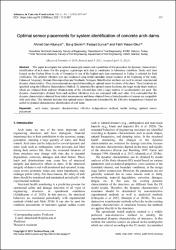| dc.contributor.author | Altunişik, Ahmet Can | |
| dc.contributor.author | Sevim, Barış | |
| dc.contributor.author | Sunca, Fezayil | |
| dc.contributor.author | Okur, Fatih Yesevi | |
| dc.date.accessioned | 2022-05-11T14:23:04Z | |
| dc.date.available | 2022-05-11T14:23:04Z | |
| dc.date.issued | 2021 | tr |
| dc.identifier.citation | Altunisik, Ahmet Can (Karadeniz Technical University, Faculty of Engineering, Department of Civil Engineering) ; Sevim, Baris (Yildiz Technical University, Faculty of Civil Engineering, Department of Civil Engineering) ; Sunca, Fezayil (Karadeniz Technical University, Faculty of Engineering, Department of Civil Engineering) ; Okur, Fatih Yesevi (Karadeniz Technical University, Faculty of Engineering, Department of Civil Engineering) | tr |
| dc.identifier.uri | https://hdl.handle.net/20.500.12418/12833 | |
| dc.description.abstract | This paper investigates the optimal sensor placements and capabilities of this procedure for dynamic characteristics identification of arch dams. For this purpose, a prototype arch dam is constructed in laboratory conditions. Berke arch dam located on the Ceyhan River in city of Osmaniye is one of the highest arch dam constructed in Turkey is selected for field verification. The ambient vibration tests are conducted using initial candidate sensor locations at the beginning of the study. Enhanced Frequency Domain Decomposition and Stochastic Subspace Identification methods are used to extract experimental dynamic characteristics. Then, measurements are repeated according to optimal sensor locations of the dams. These locations are specified using the Effective Independence Method. To determine the optimal sensor locations, the target mode shape matrices which are obtained from ambient vibration tests of the selected dam with a large number of accelerometers are used. The dynamic characteristics obtained from each ambient vibrations tests are compared with each other. It is concluded that the
dynamic characteristics obtained from initial measurements and those obtained from a limited number of sensors are compatible with each other. This situation indicates that optimal sensor placements determined by the Effective Independence Method are
useful for dynamic characteristics identification of arch dams. | tr |
| dc.language.iso | eng | tr |
| dc.relation.isversionof | 10.12989/acc.2021.11.5.397 | tr |
| dc.rights | info:eu-repo/semantics/closedAccess | tr |
| dc.subject | arch dams | tr |
| dc.subject | dynamic characteristics | tr |
| dc.subject | effective independence method | tr |
| dc.subject | modal testing | tr |
| dc.subject | optimal sensor placement | tr |
| dc.title | Optimal sensor placements for system identification of concrete arch dams | tr |
| dc.type | article | tr |
| dc.relation.journal | Advances in Concrete Construction | tr |
| dc.contributor.department | Mühendislik Fakültesi | tr |
| dc.contributor.authorID | 0000-0003-3033-6237 | tr |
| dc.identifier.volume | 11 | tr |
| dc.identifier.issue | 5 | tr |
| dc.identifier.endpage | 407 | tr |
| dc.identifier.startpage | 397 | tr |
| dc.relation.publicationcategory | Uluslararası Hakemli Dergide Makale - Kurum Öğretim Elemanı | tr |















